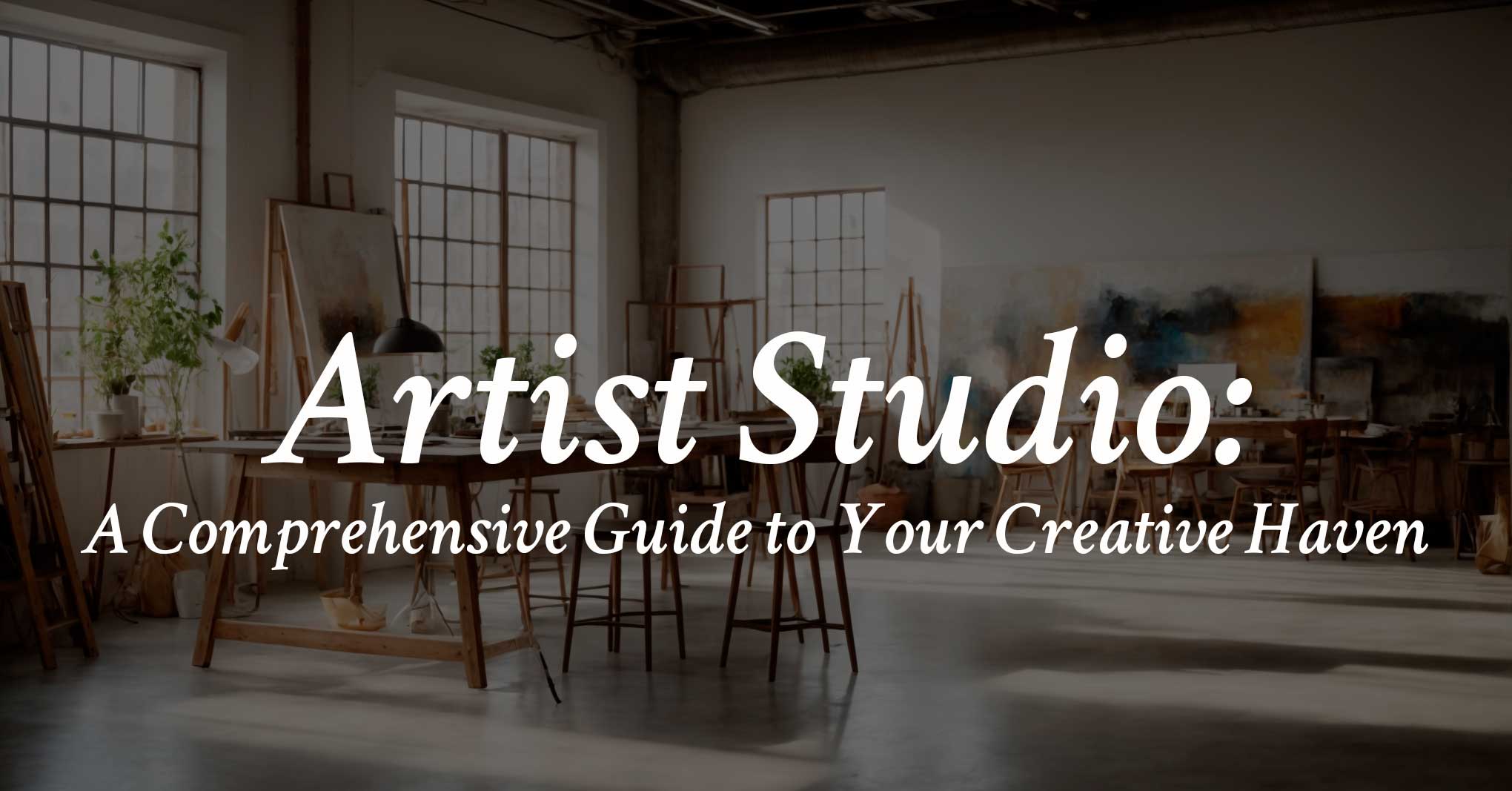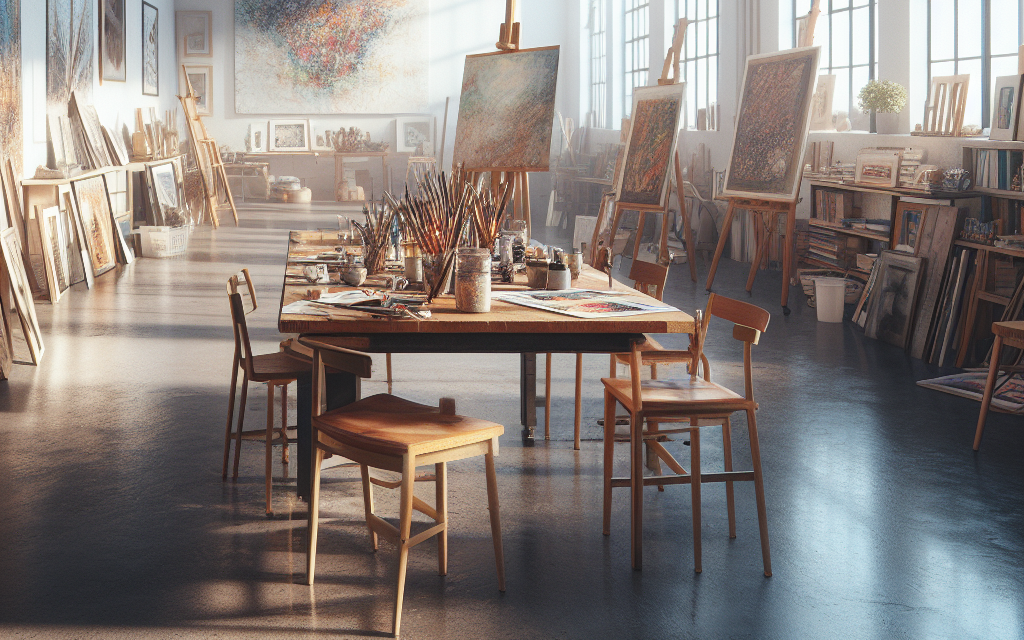
- Introduction: The Artist Studio as a Sanctuary of Creativity
- Key Elements of an Artist Studio
- Creating a Comfortable Work Environment
- Organizational Tips for Maximum Productivity
- Creative Storage Solutions for an Artist Studio
- Inspirational Studio Decor and Ambiance
- Sharing Your Studio: Hosting Art Workshops and Gatherings
- Conclusion
- FAQs
Introduction: The Artist Studio as a Sanctuary of Creativity
An artist studio is more than just a physical space; it is a haven where creativity takes flight. It’s the sacred ground where ideas flourish, and masterpieces come to life. Setting up your ideal artist studio is a journey of self-discovery and creative expression.
What is an artist studio?
An artist studio is a dedicated space where artists unleash their imagination and turn visions into tangible art. It’s a personal sanctuary that fosters creativity and provides an atmosphere conducive to artistic exploration.
How to set up an artist studio:
Creating your perfect artist studio involves thoughtful planning and consideration. From selecting the right location to organizing the space efficiently, every detail contributes to the overall vibe of your creative haven.
Essential tools and materials:
Equipping your studio with the right tools and materials is essential for a seamless creative process. From high-quality paints to specialized brushes, investing in the right equipment sets the stage for artistic excellence.
Key Elements of an Artist Studio


Your studio’s layout significantly influences the creative flow and functionality. Ensuring an optimal arrangement enhances productivity and cultivates a conducive atmosphere for inspiration.
Optimal Layout for Flow and Functionality:
Arrange your workspace with intention, allowing for easy movement and accessibility to essential tools. A well-thought-out layout encourages a harmonious creative process.
Essential Tools and Materials:
Beyond the basics, delve into specialized tools and materials that align with your artistic vision. Curate a collection that caters to your unique style, fostering a sense of identity in your creative space.
Personalization for Inspiration:
Infuse your personality into the studio decor. Surround yourself with objects and art that inspire you, creating an environment that sparks creativity and fuels your artistic journey.
Creating a Comfortable Work Environment


An artist’s studio should be a place of comfort and functionality. Focus on elements that enhance your well-being, ensuring you can immerse yourself in the creative process for extended periods.
Ergonomic Furniture and Seating:
Invest in comfortable and ergonomic furniture to support long hours of creative work. A well-designed chair and an organized workspace contribute to a comfortable and sustainable work environment.
Temperature and Climate Control:
Maintain an optimal climate in your studio, considering factors like temperature and humidity. A comfortable environment ensures that your creative energy flows uninterrupted.
Organizational Tips for Maximum Productivity
Efficient organization is key to a productive artist studio. Streamline your space, create designated storage, and implement effective systems to keep your materials accessible and your mind focused.
Creating designated storage spaces:
Assign specific areas for different types of art supplies, ensuring easy access and a clutter-free workspace. Designated storage spaces streamline your creative process.
Implementing effective organization systems:
Explore storage solutions like shelves, drawers, and containers to keep your studio organized. Establish a system that caters to your workflow, making it easy to locate materials when inspiration strikes.
Storing and preserving different types of art in an artist studio:
Protect your finished artworks from damage by implementing proper storage techniques. Safeguarding your creations ensures they stand the test of time.
Creative Storage Solutions for an Artist Studio


When it comes to organizing your artist studio, thinking creatively about storage solutions can elevate both functionality and aesthetics. Here are some innovative ideas to help you store your materials in a way that merges practicality with artistic expression:
1. Vertical Canvas Storage:
Utilize the vertical space in your studio by installing a wall-mounted canvas storage system. This not only keeps your canvases organized and easily accessible but also adds a visually interesting element to your studio. Consider using wooden dowels or metal brackets to create a modular system that accommodates canvases of various sizes.
Example: Install a series of wooden pegs on the wall to hang canvases of different sizes, creating a dynamic and ever-changing display.
2. Palette Drawer Organizer:
Keep your palettes organized and within reach by repurposing a drawer into a dedicated palette organizer. Install dividers or small containers within the drawer to separate palettes based on color schemes or specific projects.
Example: Use small plastic containers within the drawer to arrange palettes, making it easy to find the right color palette for each painting.
3. Hanging Paint Tube Rack:
Create a visually striking display for your paint tubes by designing a hanging rack. This can be achieved using a wooden or metal frame with clips or loops to hold the tubes. Not only does this solution keep your paints organized, but it also adds a splash of color to your studio walls.
Example: Attach metal clips to a wooden frame and hang it on the wall, arranging paint tubes by color for an eye-catching and practical display.
4. Found Object Storage Bins:
Embrace the artistic side of storage by repurposing found objects or vintage items into unique storage bins. Old crates, vintage suitcases, or wooden boxes can be transformed into charming containers for art supplies.
Example: Use an antique suitcase to store sketchbooks, pencils, and other small art supplies, adding a touch of vintage charm to your studio.
5. Artwork Drying Rack:
Create a dedicated space for drying your artworks by repurposing a dish drying rack or designing a custom rack with adjustable shelves. This solution not only keeps your finished pieces safe during the drying process but also serves as a functional and artistic addition to your studio.
Example: Install adjustable shelves in a wooden frame to create a drying rack that accommodates various canvas sizes and drying stages.
6. Magnetic Wall for Small Items:
Harness the power of magnets to organize small metal items such as brushes, scissors, and metal palettes. Install a magnetic wall or section in your studio, allowing you to easily rearrange and access your tools.
Example: Attach small magnets to the back of metal tools and create a magnetic wall where you can arrange and rearrange tools with ease.
7. Rolling Storage Cart:
Optimize mobility and flexibility with a rolling storage cart. This solution is perfect for frequently used items or those you want to keep within arm’s reach. Choose a cart with multiple shelves or drawers for efficient organization.
Example: Use a rolling cart to store frequently used paints, brushes, and tools, allowing you to move your essentials wherever inspiration strikes.
Incorporating these creative storage solutions not only enhances the organization of your artist studio but also transforms it into a visually captivating space that reflects your artistic personality. Experiment with different ideas and find a storage solution that sparks joy and creativity every time you enter your studio, I personally use some of the previous storage solutions on my daily bases and make my life easier.
Inspirational Studio Decor and Ambiance


Your studio’s atmosphere plays a pivotal role in shaping your creative mindset and fostering a space where inspiration flows freely. Thoughtfully selecting colors and decor is an art in itself, and it can significantly impact not only your mood but also the productivity of your artistic endeavors.
These are some important aspects to considerer in order to create an isnpirational atmpsthere in your artist studio:
1. Color Psychology:
Dive into the world of color psychology to understand the emotional and psychological effects of different hues. Consider incorporating calming blues for focus, energetic reds for passion, or earthy tones for grounding. Experiment with combinations that resonate with your personal style and the type of art you create.
Example: Use a calming palette of blues and greens to create a serene atmosphere, promoting concentration and a sense of tranquility in your studio.
2. Personalized Artwork:
Infuse your studio with your own creations or those of artists who inspire you. Surround yourself with meaningful artwork that tells a story or evokes a particular emotion. Your studio should be a reflection of your artistic journey and the influences that shape your work.
Example: Display a gallery wall of your own pieces, interspersed with works from artists who have had a profound impact on your creative vision.
3. Functional Decor:
Merge aesthetics with functionality by choosing decor items that serve a dual purpose. Consider artistic storage solutions, like decorative baskets or uniquely designed shelving units, that not only contribute to the visual appeal but also help keep your studio organized.
Example: Incorporate floating shelves that double as both display space for small sculptures and a practical storage solution for art supplies.
4. Personal Touches:
Make your studio uniquely yours by adding personal touches that resonate with your identity as an artist. This could include sentimental objects, travel souvenirs, or items that hold special significance in your creative journey.
Example: Place a vintage easel handed down from a family member in a prominent position, adding a touch of history and personal connection to your studio.
5. Adjustable Lighting:
Lighting is a crucial aspect of creating the right ambiance. Choose adjustable lighting options that allow you to control the intensity and direction of light in your studio. Natural light is ideal, but adjustable lamps and fixtures can create a dynamic environment that adapts to different creative needs.
Example: Install adjustable track lighting to highlight specific areas of your studio, ensuring that your workspace is well-lit for detailed work while maintaining a softer ambiance in other areas.
6. Sensory Elements:
Engage multiple senses by introducing elements like scented candles, soothing music, or tactile materials. Create an immersive environment that not only pleases the eyes but also stimulates your other senses, enhancing the overall creative experience.
Example: Light a candle with a calming scent, like lavender, to create a multi-sensory experience that promotes relaxation and focus in your studio.
7. Interactive Walls:
Transform your studio walls into interactive canvases. Use chalkboard or whiteboard paint to allow for spontaneous doodles, notes, or sketches. This dynamic element encourages constant engagement with your creative space.
Example: Dedicate a wall to chalkboard paint, inviting yourself to jot down ideas, sketch impromptu creations, and constantly evolve the visual landscape of your studio.
Striking a balance between functionality and aesthetics in your studio decor creates an environment that not only inspires but also supports your artistic process. Experiment with different elements until you find a combination that resonates with your unique creative spirit, turning your studio into a haven of inspiration and artistic expression.
Sharing Your Studio: Hosting Art Workshops and Gatherings


Transform your studio into a space for sharing creativity, engaging with others, and fostering artistic collaborations. Hosting workshops and events opens up new avenues for artistic expression.
Transforming Your Studio into a Space for Sharing Creativity:
Create a welcoming environment that encourages collaboration and shared creativity. Your studio can become a hub for like-minded individuals to connect and create together.
Engaging with Others: Organizing Art Workshops and Classes:
Share your expertise by organizing workshops and classes. Creating a space for learning not only benefits others but also enhances your own skills and perspectives.
Utilizing Your Studio for Community Events and Artistic Collaborations:
Extend the use of your studio beyond personal creation. Hosting community events and collaborations enriches the local artistic scene and establishes your studio as a hub for creativity.
Preserving Art: How to Store and Preserve Different Types of Art:
Educate others on the importance of proper art preservation. Share your knowledge to ensure that art remains a lasting legacy for future generations.
Conclusion
Crafting your artist studio is a deeply personal and rewarding endeavor. By focusing on optimal layout, comfort, organization, ambiance, and community engagement, you create a space that nurtures your creativity and leaves a lasting impact on the artistic community.
FAQs
- How can I create a personalized and inspiring artist studio on a budget? Embrace DIY projects, thrift store finds, and repurposed materials to infuse your studio with character without breaking the bank.
- What are the must-have tools for a beginner artist studio? Start with essentials like sketchbooks, a variety of pencils, basic paint sets, and quality brushes to build a solid foundation for your artistic journey.
- How do I deal with limited space in my artist studio? Maximize vertical space with shelves and wall-mounted storage, and prioritize multi-functional furniture to make the most of a compact studio.
- Can I use my artist studio for both personal and professional purposes? Yes, your studio can serve dual purposes. Define separate zones for personal projects and professional work to maintain focus and organization.
- What is the best way to connect with other artists and art enthusiasts in my community? Attend local art events, join online forums, and consider hosting open studio days to build connections and foster a sense of community among artists.




